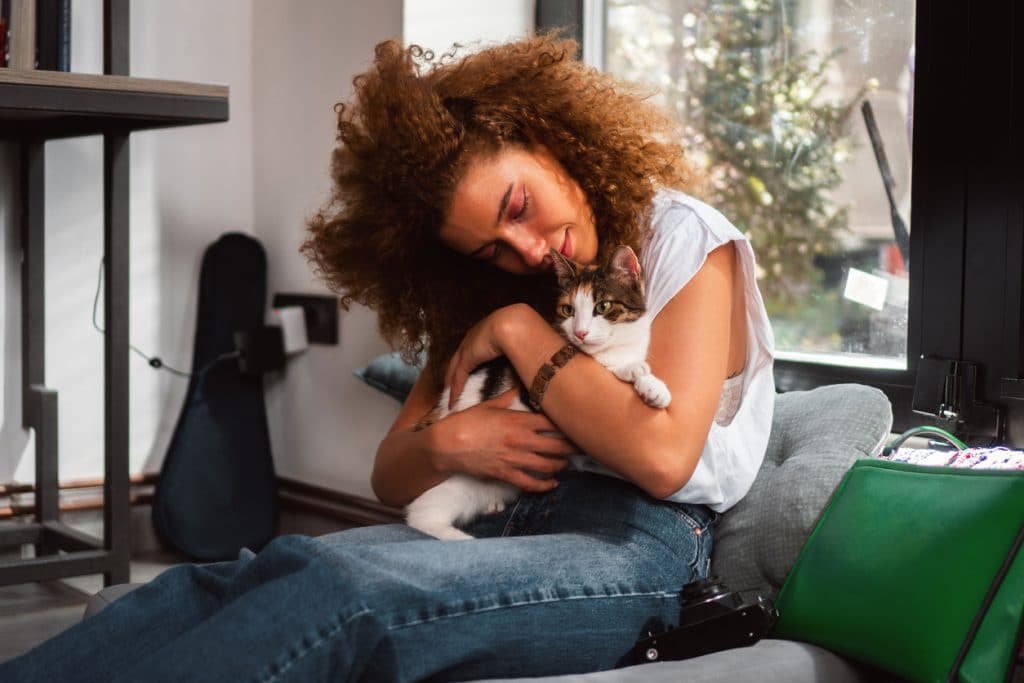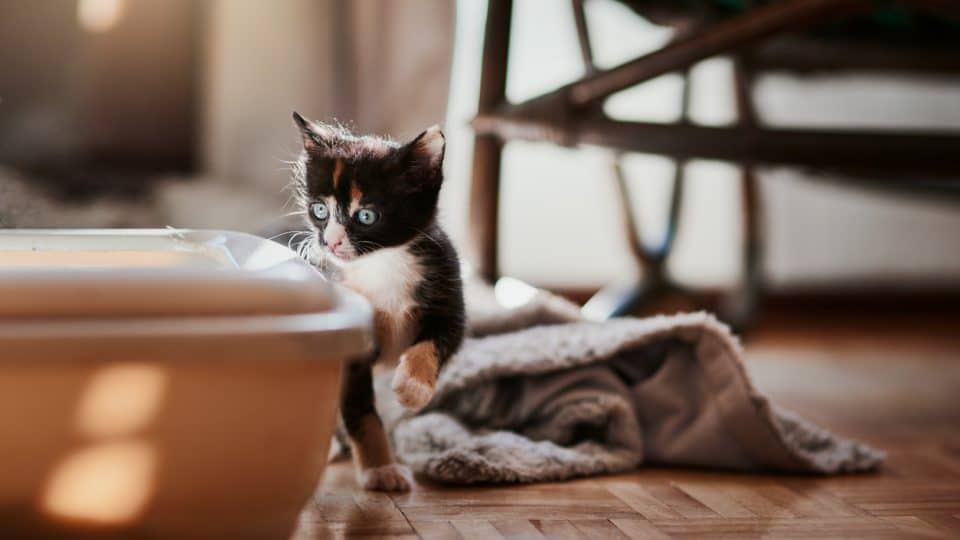It can be frustrating when cats pee outside the litter box, but rest assured your cat isn’t doing it out of spite. When cats pee outside the litter box, there is usually a reasonable explanation such as a medical condition or environmental change. Fortunately, once you identify and treat the issue, encouraging your cat to use their litter box will be much easier.
We spoke to experts such as Rita Reimers and Linda Hall, Certified Cat Behavior Training Specialists with Cat Behavior Alliance, and Dr. Mikel Delgado, a cat behavior consultant, to help understand and navigate what next steps to take when your cat peeing outside the litter box.
Read on to understand how your cat is feeling, why that can affect how they decide to pee, and how to improve your cat’s litter box environment.
Medical Reasons Your Cat Is Peeing Everywhere
If you see your cat experience loss of appetite, vomiting, or other signs of discomfort, they may be experiencing a medical issue. Georgina Ushi, Veterinarian at Pet Health Love, confirms the following medical conditions can cause inappropriate urination:
- Bladder or urine conditions: A small study looking at 41 cats found that those who peed outside their box were more likely to have a diagnosable urinary issue. Urinary issues include urinary tract infections (UTI), bladder stones, incontinence, or feline idiopathic cystitis (FIC), which cause urgent urination and peeing in unusual places. You may also notice your cat hiding in pain or discomfort.
- Feline diabetes: Cats are susceptible to developing diabetes, with Type II diabetes being more common among felines. With diabetes, you may notice symptoms including weight loss despite a normal appetite and increased thirst and urination.
- Arthritis: Difficulty getting up after resting, soreness after play, and/or the inability to enter the litter box can all be signs of arthritis in cats and lead to peeing in other places.
- Obesity: If your cat is overweight or obese, they may struggle to enter their litter box and choose to pee elsewhere.
- Kidney disease: Three out of 10 geriatric cats (age 15 or older) are diagnosed with chronic kidney disease. Symptoms of kidney disease include increased thirst, frequent urination, normal appetite with weight loss, and lack of energy.
- Hyperthyroidism: Hyperthyroidism may present as inappropriate urination, restlessness at night, and a lack of grooming. However, hyperthyroidism shares manner common symptoms with other medical conditions.
Because pain during urination causes discomfort, your cat may begin to associate the litter box with that pain. To avoid the litter box, where they think pain occurs, they’ll seek other places to pee, especially cool, smooth surfaces like a tile floor or the bathtub.
When to call a vet
According to Ushi, you should contact a veterinarian as soon as you notice:
- Sudden peeing outside the litter box
- Significant increase in drinking water
- Blood in urine
- Excessive urinating or changes in how often your cat pees
- Yowling or vocalizations while urinating
At the vet, Ushi explains that your cat will likely undergo a physical exam and a urinalysis. Depending on your cat’s symptoms, your vet may also advocate for a blood test or imaging to help diagnose the cause. These tests will help them identify whether your cat has a urinary tract infection, kidney stones, arthritis, or other possible conditions.
After diagnosis, your vet can prescribe the appropriate treatment, which may include:
- antibiotics
- arthritis supplements
- dietary changes, such as low-phosphorus cat food
- pain relief medication
Behavioral and Environmental Causes of Inappropriate Urination
If your cat does not display any medical symptoms, an environmental or behavioral issue is likely the cause of their distress. According to Reimers and Hall, the following situations could result in your cat peeing outside the litter box:
- New cat or kitten: You may confuse your cat’s reaction for jealousy but it’s more likely that your cat is stressed by the new comer.
- Stress: Any big changes like a move or new family member can cause your cat stress and a change in behavior, including peeing on the floor.
- Too few litter boxes: Multi-cat households can put extra stress on bathroom time, especially if one cat is dominant over the other. One litter box for each cat can resolve this issue.
- Dirty litter: Cats prefer clean litter boxes over dirty ones. Peeing outside a litter box may be their way of telling you to clean it more often. Some cats may also want you to change the type of litter you’re using.
- Poor litter box placement, size, or type: Research shows that if a cat feels its hard to get to a litter box, they are less likely to use it. Senior cats, for example, may feel pain when jumping into a too large or too high litter box.
- New cat or kitten: You may mistake your cat’s reaction for jealousy but it’s more likely that they’re stressed by the newcomer.
- Separation anxiety: Inappropriate urination is a common sign of separation anxiety in cats. According to Dr. Delgado, some cats experiencing separation anxiety seek out belongings that smell like their human to do their business.
Getting to the root of behavioral issues isn’t always easy and might take trial and error. If the unwanted behaviors happen while you’re not home, Dr. Delgado says to consider setting up a pet camera to capture any distress.
Do Cats Pee Out of Spite?
Cats do not pee out of spite. Getting this myth out of the way can help make way for other answers, including understanding your cat’s current behavior.
“Misbehaviors almost always have a basis in anxiety or a problem in the environment,” says Dr. Delgado. “We don’t know if cats experience emotions, like jealousy, the same way people do, but cats can get stressed and anxious.”
Keep in mind an environmental change in the house can also trigger behavioral stress. This may feel like spite, for example, if you had to move your cat’s litter box away from the baby’s new room, but your cat is more likely stressed that their life is changing.
How to Stop Your Cat from Peeing Outside the Box
When your cat is peeing outside the box, they are letting you know something needs to be addressed in their routine or environment.
1. Clean up the cat pee
You’ll want to clean up the cat pee smells right away—which means tracking the cat pee down fast. Areas that retain the smell of your cat’s urine may encourage them to keep peeing in the same spot.
“You need an effective enzyme cleaner that can remove the odor, not just cover it,” Dr. Delgado says. “My favorite product is Mister Max Anti Icky Poo Unscented.”
2. Get another litter box or switch your litter
Cats may avoid the litter box if they don’t like their litter or the box. Reimers and Hall recommend fine, sandy litter, though you may need to try different types of litter or litter boxes to find your cat’s unique preference.
If you have one cat, an extra litter box may be beneficial to give them options. If you have more than one cat, each should have at least one litter box of their own. Litter boxes should also be readily accessible, especially as your cat ages.
3. Keep the litter box and litter area clean
Place the litter box in a clutter-free, well-lit location with an opening that’s easy to get into.
“A cat’s litter box environment is important because cats are territorial and clean and want a designated place to eliminate waste,” says Reimers and Hall. “Cats’ preservation instincts are also strong, leading to their desire to have a clean litter box safe from cats outside their clan.”
Scoop every litter box one to two times a day. “Cats are very clean and prefer a box free of obstacles such as pee clumps and poop,” says Dr. Delgado. Set a monthly cleaning schedule for changing out litter and washing the box.
4. Address your cat’s stress and anxiety
For cats who are stressed because of a new kitten or dog in the home, you may need to reintroduce the animals properly. Older cats who hate kittens and new cats and dogs may need to be separated again. Newly adopted cats may need a little patience. Research shows that a shelter environment can increase the stress of a cat, causing them to pee outside the box.
During this separation, make sure your cat’s needs, from toys to feeding bowls, are accessible in a safe space. A clear, see-through litter box can also be helpful for cats in smaller spaces. If your cat is still stressed, make an appointment with a vet to discuss anxiety medications and calming pheromones.
5. Keep stray cats away
Sometimes inappropriate urination is actually your cat is spraying. Spraying is a different behavior than peeing. Cats spray because they feel threatened or territorial and roaming cats outside their house can trigger these feelings and increase anxiety.
If stray cats linger around your home, consider getting a motion-activated sound deterrent.
6. Avoid punishment
Punishing your cat for eliminating outside their litter box can cause added stress. Instead, focus on getting to the root of the problem and offer positive reinforcement with treats and praise when they use their litter box.

iStock/StockRocket
Peeing Outside the Litter Box Is a Call for Help
If your cat is suddenly peeing or pooping on the floor, bed, or other places outside their litter box, there’s likely a medical issue or environmental reaction. While it can be frustrating, remember that your cat isn’t peeing outside the litter box out of spite. It is more likely that your cat is feeling uncomfortable or stressed.
When troubleshooting why your cat pees everywhere, begin with environmental changes first to see if there’s improvement. The fix to your cat’s urination issues may be as simple as cleaning their litter box more often or changing the litter box style. If that doesn’t work, then look at recent changes in your cat’s routine and see if they may benefit from extra attention and bonding time.
If you can’t identify and resolve the problem quickly, it’s best to consult a veterinarian to rule out or identify possible medical concerns.
In the meantime, don’t forget to clean those cat pee smells with a strong enzymatic cleaner for odors and stains. You want really deep clean those areas so your cat isn’t tempted to pee outside the box again.



